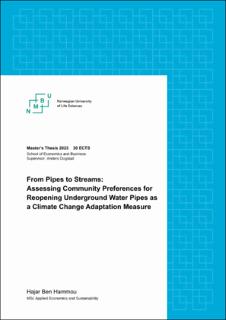| dc.description.abstract | As climate change becomes an increasingly pressing global concern, this master's thesis aims to explore the importance of green-blue infrastructure and hydrological ecosystem services. It emphasizes their importance in becoming a crucial part of strategies for climate resilience and area development in Norway. The study specifically focuses on the proposed project in Skjetten, Lillestrøm municipality, involving the reopening of old underground pipes to create a 1km long water stream named 'Melbybekken'. However, past water stream projects in other parts of Norway have received different reactions from the public and local residents, indicating a need for more knowledge in this field. To shed light on the local community's perception of such environmental goods, this thesis conducts a contingent valuation study to investigate how the residents of Skjetten value the water stream in monetary terms. With this, the study therefore aims to predict their willingness to pay and assess their preferred layout for the water stream by comparing an urban stream to a natural stream with a focus on biodiversity and recreational experiences.
Statistical techniques such as interval regression and multinomial logit models are employed to investigate the impact of predictor variables on outcome variables. The data used for the analysis is derived from a survey that garnered approximately 543 responses. The analysis reveals that, among the three alternatives (A: status quo with no water stream, B: water stream with nature-based elements, C: water stream with semi-natural elements), the residents of Skjetten overwhelmingly prefer alternative B, resembling natural water streams found in wilderness areas. On the other hand, alternative C is the second most popular choice. The interval regression estimates indicate that residents would be willing to pay around 754kr for alternative B and 582kr for alternative C. Respondents attempting to protest against the survey were excluded from the analysis.
Such findings provide valuable insights into citizen preferences for stream reopening. They can be used for cost-benefit analyses of specific projects or integrated into socioeconomic assessments to further explore how local Norwegian communities place value to smaller water bodies and other environmental assets. By understanding the preferences and wishes of the local residents, decision-makers and planners can make informed choices regarding the construction and design of the water stream. | |
